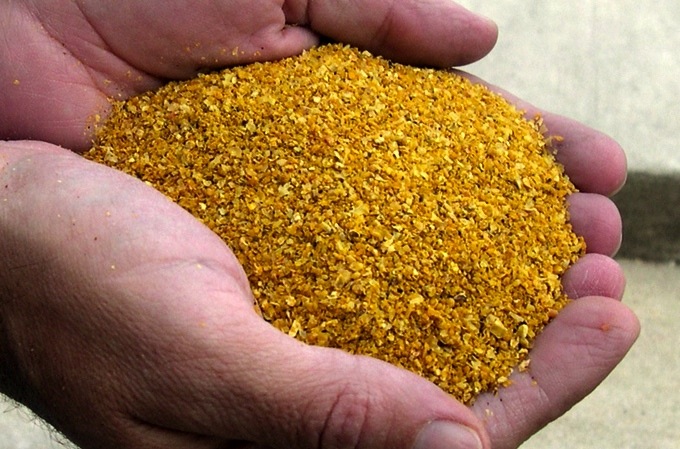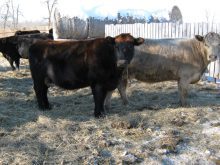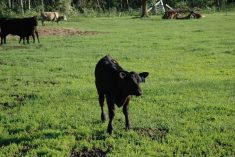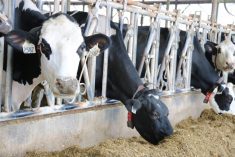Dried distillers’ grains or DDGs can be purchased from a broker for about $200 per tonne. This attractive price makes it a good feed replacement for a variety of high energy and protein supplements for growing and overwintering beef cattle. However, be aware that incoming loads of DDGs often contain high amounts of sulphur that can seriously injure cattle health and performance. It’s a good idea to test purchased DDGs for sulphur content (as well as other byproducts) to establish safe DDGs feed guidelines.
Under normal circumstances, sulphur is digested like many of the other essential minerals. Sulphur is released from ingested feed by fermentation in the rumen and is taken up by the rumen microorganisms. These bacteria convert a substantial portion of it into essential amino acids such as methionine/cysteine as well as vitamins thiamine and biotin. Such important end products are eventually taken up by cattle and are involved in many different vital functions ranging from acid-base balance of cells, carbohydrate and protein metabolism to vitamin co-factors in active enzymes.
Read Also

Harvest wraps up and fall work begins
At the Eppich famly ranch in western Saskatchewan, the fall harvest was successful with few breakdowns, cows and calves have been sorted and a new tractor has arrived
Unfortunately, it doesn’t take much sulphur in DDGs to poison cattle.
Sulphur from different sources
Sulphur toxicity in cattle begins when the total intake of sulphur from DDGs and other feed ingredients and sulphates in water exceeds an invisible boundary of 0.4 per cent of cattle’s dry matter feed intake. This level is about three times their natural sulphur requirement for beef cattle of 0.15 per cent and the starting point by which the cow’s rumen fluid literarily becomes polluted with large amounts of dissolved sulfurous compounds.
That’s because the rumen microorganisms cannot convert enough incoming dietary sulphur into the above usable S-containing nutrients. As a result, excessive amounts of hydrogen sulphide gas is produced from incomplete sulfurous rumen fermentation, which is finally belched out by cattle. Since most cattle breathe back this poisonous gas into their lungs, absorbed sulphur dioxide is then transported via the blood and ends up in their brains. It is thought this feedback induces a thiamine deficiency, which leads to a brain disorder or polioencephalomalacia (PEM).
PEM-affected herds may have one or two cattle with visible symptoms of distress, while other animals show no outward clinical signs. Because it is a brain disorder, common symptoms of PEM are: disorientation, staggering in circles, blindness and pressing their head against objects. Other associated signs are respiratory distress and reduced feed intake. Death is common among PEM animals.
Negatively affects other elements
Although, not much is known how excessive dietary sulphur induces PEM in cattle, science has proven a link between sulphur and its negative effect upon the absorption and metabolism of copper in cattle; it tends to intensify an already existing molybdenum antagonism toward copper in the cattle’s body.
With no direct reference to either PEM or a secondary copper deficiency in cattle, the general conscience among beef producers and nutritionists for years has been that 30 per cent DDGs can be added to diet of most beef cattle with no major repercussions. (i.e.: dry matter intake loss).
Because some beef producers were seeing some PEM and copper deficiencies at this approximate one-third DDGs feeding level, some ruminant specialists lowered their DDGs recommendations to 15 per cent DDGs of the diet (dry matter basis). Keep in mind when following either recommendation the sulphur content of DDGs widely ranges from 0.6 – 1.1 per cent S and ultimately each load of DDGs should be tested, respectively. More complex diets may also contain a combination of feed ingredients, with can have high sulphur levels, such as malt sprouts (0.85 per cent), canola meal (1.2 per cent), and beet pulp (1.0 per cent).
By citing these two immediate DDGs recommendations, anyone with a DDGs sulphur analysis could put their feed load to the golden rule test:
“Make sure that sulphur intake from all dietary sources (including water) does not exceed 0.4 per cent of dry matter intake.”
Test DDGs for sulphur level and calculate DDGs feeding limits to reduce the risk of sulphur toxicity.
















